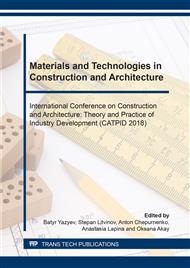[1]
M. Arandigoyen, J.I. Álvarez, Carbonation process in lime pastes with different water, Materiales de Construcción. 56, 281 (2006) 5-18.
DOI: 10.3989/mc.2006.v56.i281.88
Google Scholar
[2]
D.X. Xuan, B.J. Zhan, C.S. Poon, Development of a new generation of eco-friendly concrete blocks by accelerated mineral carbonation, Cement Concrete Comp. 133 (2016) 1235-1241.
DOI: 10.1016/j.jclepro.2016.06.062
Google Scholar
[3]
S. Monkman, M.D. Mark, Carbon dioxide upcycling into industrially produced concrete blocks, Constr. Build. Mater. 124 (2016) 127-132.
DOI: 10.1016/j.conbuildmat.2016.07.046
Google Scholar
[4]
D. Xuan, B. Zhan, C.S. Poon, H.W. Zheng, K.K.W. Kwok, Carbon dioxide sequestration of cement slurry waste and valorisation of FRCAs in eco-construction products by carbonation, 14th International Congress on the Chemistry of Cement (ICCC 2015), in Beijing, China. October 13-16 (2015).
DOI: 10.1016/j.conbuildmat.2016.03.109
Google Scholar
[5]
S.C. Kou, B.J. Zhan, C.S. Poon, Use of a CO2 curing step to improve the properties of concrete prepared with recycled aggregates, Cement Concrete Comp. 45 (2014) 22-28.
DOI: 10.1016/j.cemconcomp.2013.09.008
Google Scholar
[6]
B.J. Zhan, D. Xuan, C.S. Poon, C.J. Shi, Effect of curing parameters on CO2 curing of concrete blocks containing recycled aggregates, Cement Concrete Comp. 71 (2016) 122-130.
DOI: 10.1016/j.cemconcomp.2016.05.002
Google Scholar
[7]
B. Savija, M. Lukovic, Carbonation of cement paste: understanding, challenges, and opportunities, Constr. Build. Mater. 117 (2016) 285-301.
Google Scholar
[8]
C. Shi, Y. Wu, Studies on some factors affecting CO2 curing of lightweight concrete products, Resour. Conserv. Recy. 52 (2008) 1087-1092.
DOI: 10.1016/j.resconrec.2008.05.002
Google Scholar
[9]
K.H. Sormeh, G. Subhasis, Physico-chemical processes limiting CO2 uptake in concrete during accelerated carbonation curing, Ind. Eng. Chem. Res. 52 (2013) 5529-5537.
DOI: 10.1021/ie303275e
Google Scholar
[10]
B.V. Osin, Quicklime as a new binding agent, Promstroyizdat, Moscow, (1954).
Google Scholar
[11]
M.M. Sychev, Systematization of binders, Journal of Applied Chemistry. 3 (1970) 528-533.
Google Scholar
[12]
M.M. Sychev, The emergence of hardening structures as a process of self-organization, Works VNIIhimprom. 97 (1998) 115-119.
Google Scholar
[13]
N.V. Lyubomirskiy, S.I. Fedorkin, Scientific and technological principles of disposal of carbon dioxide in food-grade, biodegradable building products, Biosphere Compatibility: Person, Region, Technology. 4 (16) (2016) 39-49.
Google Scholar
[14]
N.V. Lyubomirskiy, S.I. Fedorkin, M.A. Lukianchenko, System based on lime carbonizing hardening, Stroitel'nye Materialy [Construction Materials]. 11 (2008) 45-47.
Google Scholar


